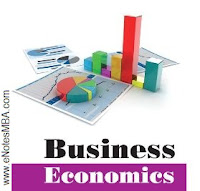Nature and Scope of Business Economics
Question: What do you mean by Business Economics? Also explain the nature and scope of business economics.
Business Economics, also called Managerial Economics, is the application of economic theory and methodology to business. Business involves decision-making; and business economics serves as a bridge between economic theory and decision-making in the context of business. Economic theories, economic principles, economic laws, economic equations, and economic concepts are used for decision making.
Definition of Business Economics
According to Spencer and Seigelman, “Managerial Economics is the integration of economic theory with business practice for the purpose of facilitating decision making and forward planning by management.”
According to Douglas, “Managerial economics is concerned with the application of economic principles and methodologies to the decision making process within the firm or organization. It seeks to establish rules and principles to facilitate the attainment of the desired economic goals of management”.
Managerial Economics is a link between two disciplines, which are management and economics. The management discipline focuses on a number of principles that aid the decision-making process of organizations. On the other hand, economics is related to an optimum allocation of limited resources for attaining the set objectives of organizations.
Before explaining the nature and scope of business economics let's first understand the distinction between Micro Economics and Macro Economics
Micro-Economics is considered to the basic economics. Microeconomics studies the economic behavior of individual unit, may be a person, a particular household, or a particular firm. It is a study of one particular unit rather than all the units combined together. Most production and welfare theories are of the microeconomics variety. Following are some of the areas that comes under microeconomics:-
- Product pricing;
- Consumer behavior;
- Factor pricing; and
- The economic conditions of a section of people.
Macro-Economics may be defined as that branch of economic analysis which studies behavior of not one particular unit, but of all the units combined together. Macroeconomics is a study in aggregates. hence, it is often called aggregative economics. Macroeconomics focuses on the growth of an economy as a whole by undertaking the study of various economic aggregates, such as aggregate supply and demand, changes in employment, gross domestic product (GDP), overall price levels, and inflation. Following are some of the areas that comes under macroeconomics:-
- National Income and National Output;
- The general price level and interest rates;
- Balance of trade and balance of payments;
- External value of currency;
- The overall level of savings and investment; and
- The level of employment and rate of economic growth.
Nature of Business Economics
Business Economics is a Science: Science is a systematized body of knowledge which establishes cause and effect relationships. Business Economics integrates the tools of decision sciences such as Mathematics, Statistics and Econometrics with Economic Theory to arrive at appropriate strategies for achieving the goals of the business enterprises. It follows scientific methods and empirically tests the validity of the results.
Based on Micro Economics: Business Economics is based largely on Microeconomics. A business manager is usually concerned about achievement of the predetermined objectives of his organisation so as to ensure the long-term survival and profitable functioning of the organization. Since Business Economics is concerned more with the decision making problems of individual establishments, it relies heavily on the techniques of Microeconomics.
Incorporates elements of Macro Analysis: A business unit does not operate in a vacuum. It is affected by the external environment of the economy in which it operates such as, the general price level, income and employment levels in the economy and government policies with respect to taxation, interest rates, exchange rates, industries, prices, distribution, wages and regulation of monopolies. All these are components of Macroeconomics. A business manager must be acquainted with these and other macroeconomic variables, present as well as future, which may influence his business environment.
Business Economics is an art: it involves practical application of rules and principles for the attainment of set objectives.
Use of Theory of Markets and Private Enterprises: Business Economics largely uses the theory of markets and private enterprise. It uses the theory of the firm and resource allocation in the backdrop of a private enterprise economy.
Pragmatic in Approach: Microeconomics is abstract and purely theoretical and analyses economic phenomena under unrealistic assumptions. In contrast, Business Economics is pragmatic in its approach as it tackles practical problems which the firms face in the real world.
Interdisciplinary in nature: Business Economics is interdisciplinary in nature as it incorporates tools from other disciplines such as Mathematics, Operations Research, Management Theory, Accounting, marketing, Finance, Statistics and Econometrics.
Normative in Nature: Economic theory has developed along two lines – positive and normative. A positive or pure science analyses cause and effect relationship between variables in an objective and scientific manner, but it does not involve any value judgement. As against this, a normative science involves value judgement. It is prescriptive in nature and suggests ‘what should be’ a particular course of action under given circumstances. Welfare considerations are embedded in normative science.
Business Economics is generally normative or prescriptive in nature. It suggests the application of economic principles with regard to policy formulation, decision-making and future planning. However, if the firms are to establish valid decision rules, they must thoroughly understand their environment.
Scope of Business Economics
The scope of Business Economics may be discussed under the following two heads:-
Demand Analysis and Forecasting: Demand Analysis pertains to the behavior of consumers in the market. It studies the nature of consumer preferences and the effect of changes in the determinants of demand such as, price of the commodity, consumers’ income, prices of related commodities, consumer tastes and preferences etc.
Demand Forecasting is the technique of predicting future demand for goods and services on the basis of the past behavior of factors which affect demand. Accurate forecasting is essential for a firm to enable it to produce the required quantities at the right time and to arrange, well in advance, for the various factors of production viz., raw materials, labor, machines, equipment, buildings etc. Business Economics provides the manager with the scientific tools which assist him in forecasting demand.
Production and Cost Analysis: Production theory explains the relationship between inputs and output. A business economist has to decide on the optimum size of output, given the objectives of the firm. He has also to ensure that the firm is not incurring undue costs. Production analysis enables the firm to decide on the choice of appropriate technology and selection of least - cost input-mix to achieve technically efficient way of producing output, given the inputs. Cost analysis enables the firm to recognize the behavior of costs when variables such as output, time period and size of plant change. The firm will be able to identify ways to maximize profits by producing the desired level of output at the minimum possible cost.
Inventory Management: Inventory management theories pertain to rules that firms can use to minimize the costs associated with maintaining inventory in the form of ‘work-in-process,’ ‘raw materials’, and ‘finished goods’. Inventory policies affect the profitability of the firm. Business economists use methods such as ABC analysis, simple simulation exercises and mathematical models to help the firm maintain optimum stock of inventories.
Market Structure and Pricing Policies: Analysis of the structure of the market provides information about the nature and extent of competition which the firms have to face. This helps in determining the degree of market power (ability to determine prices) which the firm commands and the strategies to be followed in market management under the given competitive conditions such as, product design and marketing. Price theory explains how prices are determined under different kinds of market conditions and assists the firm in framing suitable price policies.
Resource Allocation: Business Economics, with the help of advanced tools such as linear programming, enables the firm to arrive at the best course of action for optimum utilization of available resources.
Theory of Capital and Investment Decisions: For maximizing its profits, the firm has to carefully evaluate its investment decisions and carry out a sensible policy of capital allocation. Theories related to capital and investment provide scientific criteria for choice of investment projects and in assessment of the efficiency of capital. Business Economics supports decision making on allocation of scarce capital among competing uses of funds.
Profit Analysis: Profits are, most often, uncertain due to changing prices and market conditions. Profit theory guides the firm in the measurement and management of profit under conditions of uncertainty. Profit analysis is also immensely useful in future profit planning.
Risk and Uncertainty Analysis: Business firms generally operate under conditions of risk and uncertainty. Analysis of risks and uncertainties helps the business firm in arriving efficient decisions and in formulating plans on the basis of past data, current information and future prediction.
2. Macroeconomics applied to environmental or external issues
Environmental factors have significant influence upon the functioning and performance of business. The major macro economic factors are related to:-
- the type of economic system
- stage of business cycle
- the general trends in national income, employment, prices, saving and investment.
- government’s economic policies like industrial policy, competition policy, monetary and fiscal policy, price policy, foreign trade policy and globalization policies
- working of financial sector and capital market
- socio-economic organisations like trade unions, producer and consumer unions and cooperatives.
- social and political environment.
Business decisions cannot be taken without considering these present and future environmental factors. As the management of the firm has no control over these factors, it should fine-tune its policies to minimize their adverse effects.





